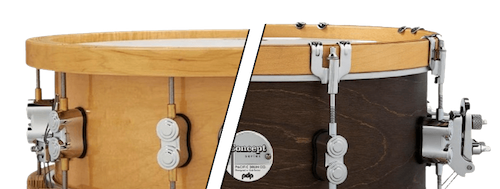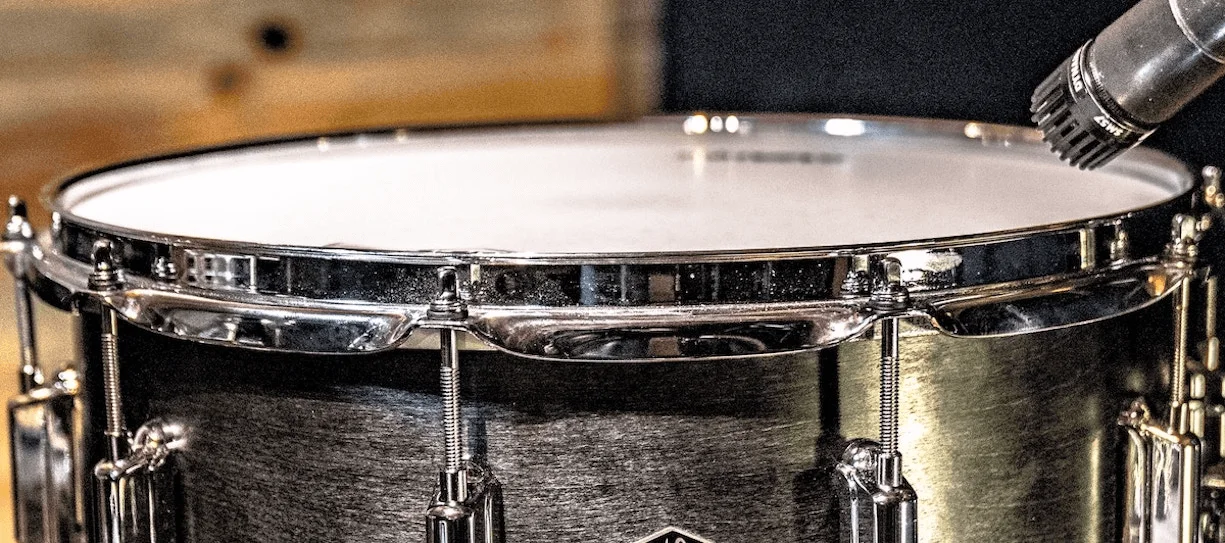Hoops often get overlooked when compared to other drum components. Shell materials, dimensions, and finishes come to the forefront of drummers’ minds, but hoops play a vital role in the sound and performance of any drum. A little hoop knowledge can go a long way helping drummers understand their instruments. That’s what we’ll get into here.
Specifically, we’ll talk about snare and tom hoops, since they have a lot more variety than bass drum hoops. We’ll get into the major design versions, their differences, and discuss the pros and cons of each type. In the end, the information should be able to help you in the future, whether you’re making a drum purchase, re-heading a drum, or just trying to understand why your drums sound the way they do.
Here’s all about drum hoops!
Wood Hoops

Wood hoops are used almost exclusively on bass drums, but they can also be used on snares and toms to create a unique sound. There are two main versions. The first is the style typically seen on bass drums, using a thinner wood design and requiring claws. Other, more modern versions, are thicker and have drilled tension rod holes. While both versions are wood, they’re quite different in both sound and performance.
Tonal Quality:
Traditional Design: The tone of claw-style wood hoops is very warm and dark. Wood accentuate low-end frequencies, especially when the wood is thin. For snare drums, that combination comes with less cut and articulation, as well as a grittier resonance. On toms, those characteristics are less prevalent.
Modern Design: Thicker wood hoops with tension rod holes are also warm when compared to most metal hoops. However, the added thickness of the modern design increases both articulation and volume. That can be a big plus with snare drums. Snare attack and resonance are cleaner with modern wood hoops than with traditional wood hoops.
Performance:
Tuning: Wood hoops have a smaller tuning range than most other hoop designs. That’s especially true with traditional hoops with claws. Thin wood can’t apply much tension to drum heads, so those hoops are best used at lower tunings. Modern wood hoops have a wider tuning range than traditional styles. The added thickness can comfortably handle low to medium tensions.
Rim Shots/Cross-Sticks: Traditional hoops have a very subtle rimshot and cross-stick tone. They also have some downsides to watch out for. First, you want to be careful when using thin wood hoops. They can dent, or even break, if hit hard enough. Second, some claw designs cause tension rods to lay above the edge of the hoop, making it possible to strike tension rods while playing.
Modern wood hoops don’t have those performance concerns, although they can dent. Many players like the rimshot and cross-stick tones of thicker wood snare hoops. The sound is typically very full and warm. Rimshots won’t cut like they do on most metal hoops, but they’re louder than traditional wood designs.
Common Applications:
Wood hoops have seen a recent resurgence on both snare drums and toms. These hoops give drummers an extra-warm tone, which is a sound many modern drummers like. Traditional wood hoops are less expensive than the thicker, more modern versions, which is why traditional hoops can be found on semi-pro drum sets.
Modern-style wood hoops are less common. They can be quite expensive, so you’re less likely to see them on full drum sets. Drum companies are more likely to include these hoops on snare drums, where the benefits are most clearly heard.
See on Drum Factory Direct
Single-Flanged Hoops

Single-flanged hoops are the least common types of hoops on this list. While more prevalent decades ago, these hoops are now typically seen on high-end drums for a vintage look and feel. Single-flanged hoops consist of a straight metal cylinder, with a small lip on the bottom edge. That lip helps the hoops stay on the drum head, and is considered the hoop’s one flange. With no tension rod holes, single-flanged hoops require claws, similar to a bass drum hoop.
Tonal Quality:
Single-flanged hoops generally provide a dark and earthy sound. Notes have a round and subtle attack, followed by a lengthened decay and increased overtones. Many single-flanged designs use lightweight materials, which enhances the dark character even more. These hoops don’t project much, although they can provide a rich tone at soft to medium volumes.
Performance:
Tuning: This type of hoop design has a smaller tuning range than other metal hoops. Because the materials are usually more flexible, higher tensions can be difficult. The hoop can slip off the drum head and lightweight claws can even bend under enough pressure. Single-flanged hoops perform best at low to medium tensions.
Rim Shots/Cross-Sticks: Certain single-flanged claw designs can cause problems for drummers. In the image above, for example, tension rods and/or claws lay above the hoop itself. It’s a look many vintage drum fans like, but it can also be easy to hit that hardware while playing if you’re not careful. The sound of both rimshots and cross-sticks are warmer and softer than most other metal hoops.
Common Applications:
Due to the dark and subdued tonal character of single-flanged hoops, they’re not very common in modern drumming. They’re seen mostly in orchestral settings, rather than where more volume is needed. Microphones tend to amplify the hoops’ added overtones more than many drummers prefer, so these hoops work best in acoustic environments.
See on Drum Factory Direct
Triple-Flanged Hoops

Triple-flanged designs are the most common style of drum hoops, by far. They come in a variety of thicknesses, but all have roughly the same shape. One flange adds support around the drumhead. A second is there to provide a flat surface for tension rod holes and to apply pressure to the head. The third flange gives drumsticks a rounded surface to strike. These hoops are easy to make, don’t require any claws, and are typically very durable.
This hoop design is often segmented into three thickness categories – thin, medium, and thick. Thin hoops are under 2mm thick (1.6mm is common). Medium hoops are between 2mm and about 2.5mm (2.3mm is common). Thick hoops are over 2.5mm (3mm is common).
Tonal Quality:
In general, triple-flanged hoops are more balanced than any other type of hoop. They have a good mix of resonance and brightness. The thickness of the hoop determines more specific sonic details, however. Thin triple-flanged hoops tend to be more open and dark, with more overtones and less articulation. Thicker versions have a slightly drier and brighter tone, with a cleaner resonance and more articulation.
Performance:
Tuning: Triple-flanged hoops are easy to tune. The tuning range lays towards the middle of the sound spectrum, although hoop thickness plays a part. Thin hoops have less precise tuning, and the tuning doesn’t hold as well. Thicker triple-flanged hoops have more rigidity, applying a more even pressure for more stable tuning.
Rim Shots/Cross-Sticks: Again, the thickness of a triple-flanged hoop will play a role in how it sounds when struck. Thin triple-flanged hoops are darker sounding, with less volume, almost like single-flanged hoops. Thicker triple-flanged hoops have a more robust rimshot and cross-stick sound, providing a more balanced blend of volume and tone.
Common Applications:
Thin triple-flanged hoops are very common on student drum sets. They’re cheap, easy to manufacture, and are fairly easy to tune. Medium triple-flanged hoops are seen on many mid-level and professional drum sets. They’re the most balanced type of drum hoop available, working well for the largest number of drumming situations. Thick triple-flanged hoops are also very balanced, but they cost more. They’re seen mainly on professional drums, giving drummers extra attack and volume.
See Thin on Drum Factory Direct
See Medium on Drum Factory Direct
See Thick on Drum Factory Direct
Die-Cast Hoops

Die-cast hoops are made using an age-old process. Rather than being stamped, like flanged hoops, die-cast hoops are constructed by pouring molten metal into a cast. That’s an expensive way to make a drum hoop, but it’s the only way to achieve the rigidity that die-cast hoops provide. The resulting sound is one that can’t be duplicated any other way. Most die-cast hoops are quite heavy. Yamaha makes them with lighter materials, while retaining many of the benefits of the design.
Tonal Quality:
Die-cast hoops provide the brightest tone of all the hoops on this list. After a strong initial attack, the resonance consists of an increases amount of higher frequencies. The tone tends to be fairly pure throughout, although die-cast usually shortens the decay a bit. Stick attack is stronger as well, making it a good choice for drummers looking for extra volume and articulation.
Performance:
Tuning: These hoops have a slightly smaller tuning window than medium or thick triple-flanged hoops. There’s a lot of overlap, but the very lowest tunings you can get with standard triple-flanged hoops may not be as achievable with die-cast. Of course, using a slightly darker head can bring out more low-end when using a die-cast hoop. When tuned anywhere above super-low, these hoops are usually easy to tune.
Rim Shots/Cross-Sticks: Rimshots and cross-sticks are major reasons many drummers like die-cast snare drum hoops. The sound cracks, with a full-bodied, strong tone. Because these hoops are so solid, tone resonates through them freely. While there isn’t a flattened edge on top, like triple-flanged hoops, die-cast hoops are usually fairly rounded. Stick damage is normal for most drummers.
Common Applications:
Die-cast hoops are expensive to make, so they’re not as common as triple-flanged designs. They’re typically seen on higher-end drums. Die-cast hoops are a great option for live drummers who want strong attack that cuts through a mix. It’s common for drummers to have die-cast hoops on their snare drums, where the extra articulation and crack are most needed, along with triple-flanged hoops on their toms. Others like the extra brightness and volume all around the kit, using them across the board.
See on Drum Factory Direct
Wrap-Up
That’s it! Hopefully you now have a better understanding of different types of drum hoops. For something that’s easy to overlook, hoops really do make a difference. Some can give you an extreme sound, while others are much more versatile. All have pros and cons in performance, sound, and cost. Even though there’s more information to sort through, it’s great to have so many options nowadays!
By Peter Treuden – About the Author
Want to learn about all about drumsticks? Check out our guide here!

